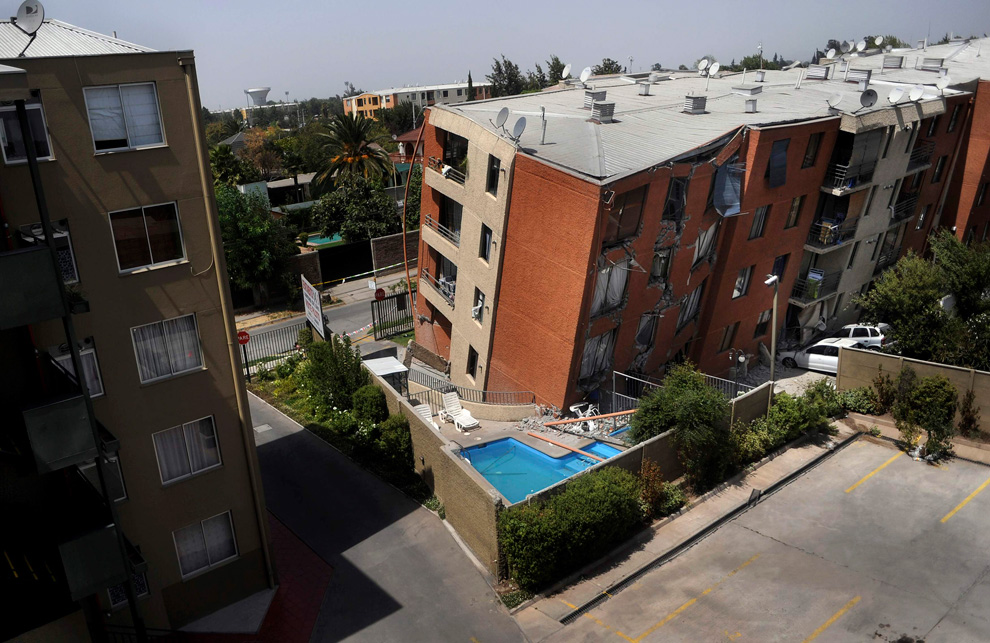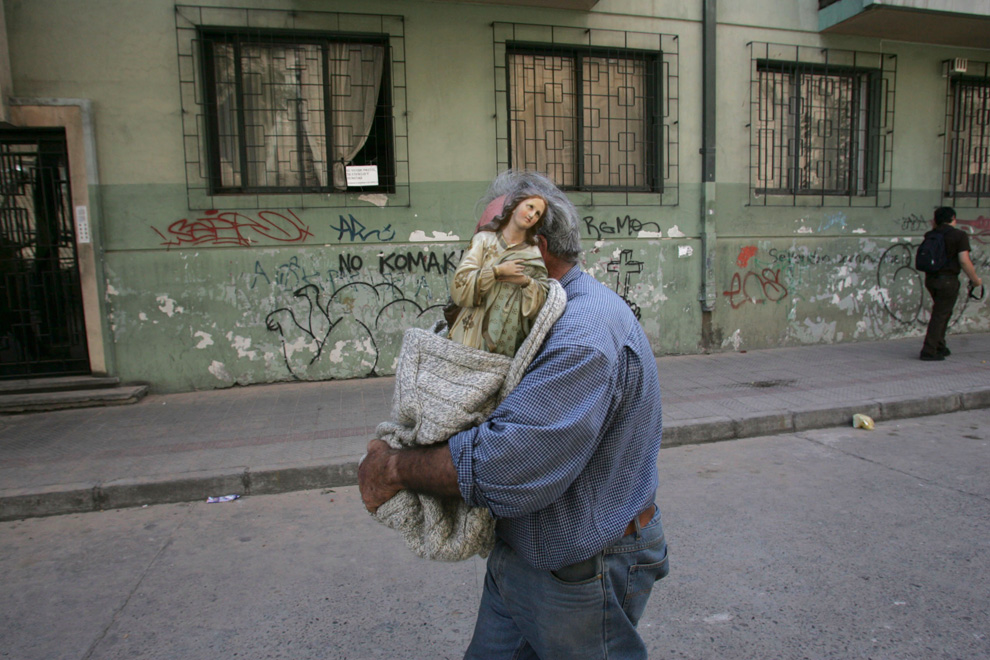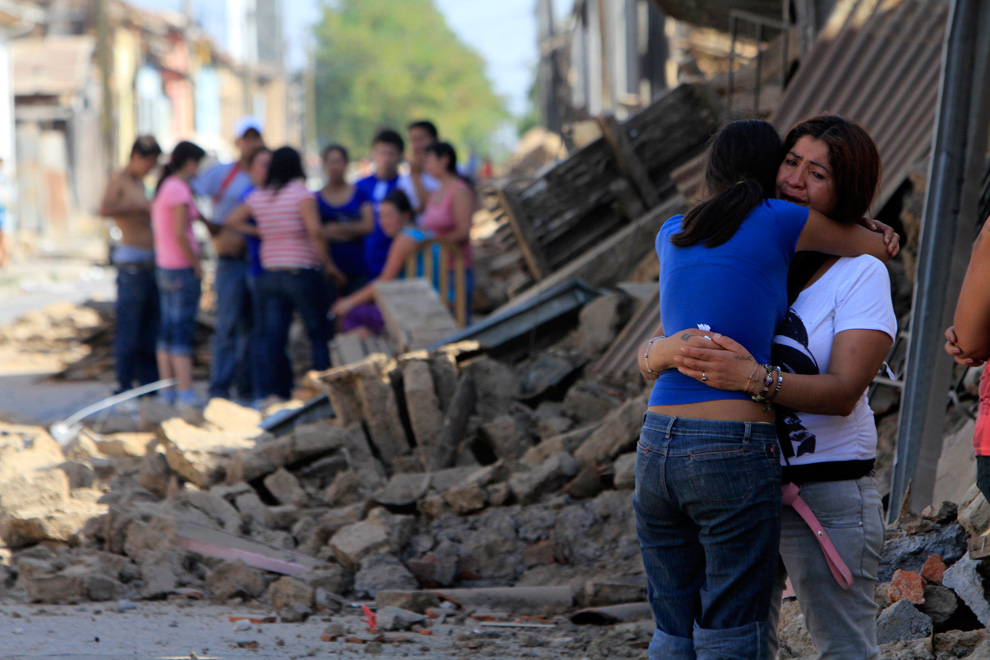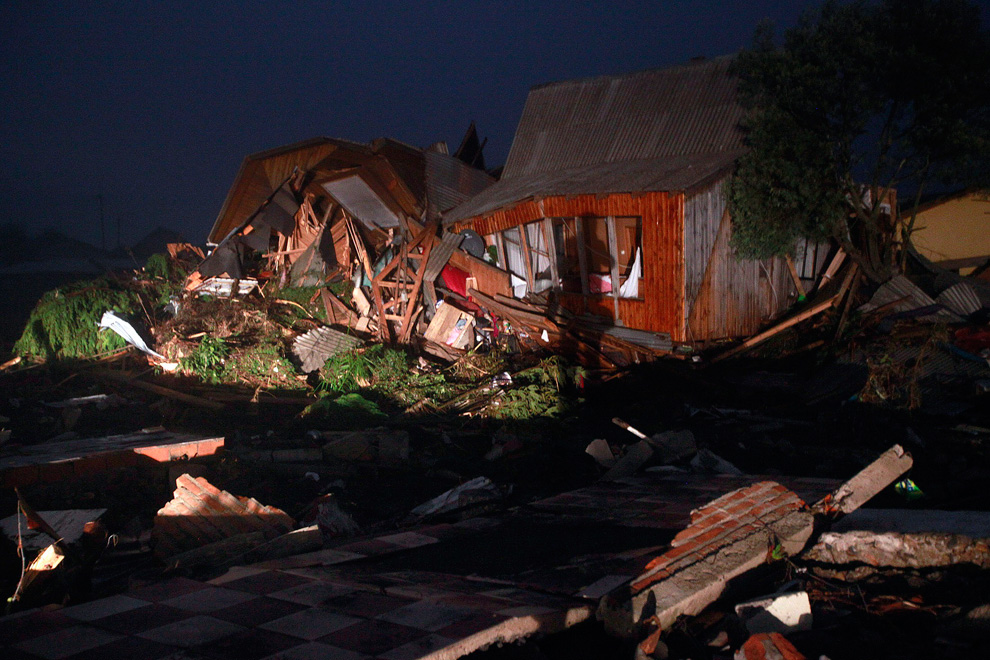* Person above 18 years of age and over 50 Kgs. in weight can donate blood once in three months.
* A normal adult has five to six liters of blood in his/her body of which only 300 ml is used during blood donation.
* This blood is replaced by your body within 24 to 48 hours!
* No special diet, rest or medicine is required after blood donation.
* The donor should not have taken any medicine in the last 48 hours.
* The donor should not have contacted jaundice in the previous three years.
* Every donor is given a medical checkup prior to donation to see if he/she is medically fit and doesn't suffer from anemia, high blood pressure etc.,
* The donor cannot contract AIDS or any other disease by donating blood.
Facts about blood donation
EDUCATION, GENERAL KNOWLEDGE, HEALTH, HELPSecretary of State Hillary Clinton presents award to Jansila Majeed of Sri Lanka
EDUCATION, GENERAL KNOWLEDGEUS Secretary of State Hillary Clinton presented the Women of Courage award to Sri Lanka’s Jansila Majeed at a ceremony held at the US State Department in Washington, Wednesday, March 10. Majeed was among 10 recipients of the 2010 award.
First lady Michelle Obama and Secretary of State Hillary Rodham Clinton present the 2010 International Women of Courage Award to Jansila Majeed of Sri Lanka, Wednesday, March 10, 2010, at the State Department in Washington ~ AP pic.Tawbah (Repentance)
Women Of Courage Awards
Award goes to women who have shown exceptional courage and leadership in advocating for human rights and women’s equality:
U.S first lady Michelle Obama (L) is pictured on stage with the 2010 International Women of Courage Awards recipients at the State Department in Washington, March 10, 2010. With Obama are (2nd L-R) Afghanistan' s Shukria Asil and Shafiqa Quraishi, Sonia Pierre of the Dominican Republic, Kenya's Ann Njogu, Korea's Lee Ae-Run, Sri Lanka's Jansila Majeed, Syria's Sister Marie Claude Naddaf and Zimbabwe's Jestina Mukoko-Reuters pic
Ms. Majeed is the Managing Trustee of Community Trust Fund in Puttalam province. The Trust oversees a number of programs on minority and women’s issues, including women’s rights, peace building, relief work, working with young people, and mine-risk education in the North and East. Ms. Majeed’s own particular focus is on uniting the Muslim and Tamil communities in her province.
Having lived as an internally displaced person (IDP) for almost 20 years, Ms. Majeed has become an energetic activist for services for displaced Muslim and Tamil civilians, focusing particularly on grassroots programs on life skills, health, and women's empowerment. Her activism began in 1992 with a working group of five people. She overcame both the general neglect of the problem of IDPs in the Muslim minority as well as her own community’s strictures against women activists to build a broad-based organization that works on minority and women’s issues in a highly sensitive and politicized environment.
A Complete Health Guide
EDUCATION, GENERAL KNOWLEDGE, HEALTH, HELPEXERCISE AND FITNESS STAMINA EXERCISES |
SLEEPING TOO LATE -LIVER DAMAGE
EDUCATION, GENERAL KNOWLEDGE, HEALTH Good rest and sound sleep is very Important... if u don't sleep well, The toxic in your body will accumulate..Affecting your health and your mood....
Good rest and sound sleep is very Important... if u don't sleep well, The toxic in your body will accumulate..Affecting your health and your mood....The main causes of liver damage are:
1. Sleeping too late and waking up too late are the main cause.
2. Not urinating in the morning.
3. Too much eating.
4. Skipping breakfast.
5. Consuming too much medication.
6. Consuming too much preservatives, additives, food coloring, and artificial weetener.
7. Consuming unhealthy cooking oil. As much as possible reduce cooking oil use when frying, which includes even the best cooking oils like olive oil. Do not consume fried foods when you are tired, except if the body is very fit..
8. Consuming overly done foods also add to the burden of liver. Veggies should be eaten raw or cooked 3-5 parts. Fried veggies should be finished in one sitting, do not store.
We just have to adopt a good daily lifestyle and eating habits.. Maintaining good eating habits and time condition are very important for our body to absorb and get rid of unnecessary chemicals according to 'schedule.'
Because:
Evening at 9 - 11pm : is the time for eliminating unnecessary/ toxic chemicals (de-toxification) from the antibody system (lymph nodes). This time duration should be spent by relaxing or listening to music. If during this time a housewife is still in an unrelaxed state such as washing the dishes or monitoring children doing their homework, this will have a negative impact on her health.
Because:
Evening at 9 - 11pm : is the time for eliminating unnecessary/ toxic chemicals (de-toxification) from the antibody system (lymph nodes). This time duration should be spent by relaxing or listening to music. If during this time a housewife is still in an unrelaxed state such as washing the dishes or monitoring children doing their homework, this will have a negative impact on her health.
Evening at 11pm - 1am : The de-toxification process in the liver, and ideally should be done in a deep sleep state. Early morning 1 - 3am : de-toxification process in the gall, also ideally done in a deep sleep state.
Early morning 3 - 5am : de-toxification in the lungs. Therefore there will sometimes be a severe cough for cough sufferers during this time. Since the de-toxification process had reached the respiratory tract, there is no need to take cough medicine so as not to interfere with toxin removal process.
Morning 5 - 7am : de-toxification in the colon, you should empty your bowel.
Morning 7 - 9am : Absorption of nutrients in the small intestine, you should be having breakfast at this time. Breakfast should be earlier, before 6:30am, for those who are sick. Breakfast before 7:30am is very beneficial to those wanting to stay fit. Those who always skip breakfast, they should change their habits, and it is still better to eat breakfast late until 9 -10am rather than no meal at all. Sleeping so late and waking up too late will disrupt the process of removing unnecessary chemicals. Aside from that, midnight to 4am is the time when the bone marrow produces blood.
Sri Lankan woman activist U.S. State Department's 2010 International Women of Courage Award Winner
EDUCATION, GENERAL KNOWLEDGE, ISLAM
A Sri Lankan woman activist for the displaced civilians is among the 10 winners of this year's United States Department of State International Women of Courage (IWOC) award.
 Ms. Jansila Majeed, a displaced person herself for 20 years, is one of the winners announced by the U.S. Secretary of State Hilary Clinton on Monday. Secretary Clinton will present the awards to the honorees at the Department of State in Washington on March 10.
Ms. Jansila Majeed, a displaced person herself for 20 years, is one of the winners announced by the U.S. Secretary of State Hilary Clinton on Monday. Secretary Clinton will present the awards to the honorees at the Department of State in Washington on March 10.
The annual International Women of Courage Award, started in March 2007 by former Secretary of State Condoleezza Rice, recognizes women around the globe who have shown exceptional courage and leadership in advocating for women's rights and advancement.
According to Ms. Majeed's bio published by the State Department, she is the Managing Trustee of Community Trust Fund in Puttalam province which oversees a number of programs on minority and women's issues, including women's rights, peace building, relief work, working with young people, and mine-risk education in the North and East.
Ms. Majeed's own particular focus is on uniting the Muslim and Tamil communities in her province.
"Having lived as an internally displaced person (IDP) for almost 20 years, Ms. Majeed has become an energetic activist for services for displaced Muslim and Tamil civilians, focusing particularly on grassroots programs on life skills, health, and women's empowerment. Her activism began in 1992 with a working group of five people. She overcame both the general neglect of the problem of IDPs in the Muslim minority as well as her own community’s strictures against women activists to build a broad-based organization that works on minority and women’s issues in a highly sensitive and politicized environment," the bio reads.
The other recipients of the award are: Shukria Asil (Afghanistan), Col. Shafiqa Quraishi (Afghanistan), Androula Henriques (Cyprus), Sonia Pierre (Dominican Republic), Shadi Sadr (Iran), Ann Njogu (Kenya), Dr. Lee Ae-ran (Republic of Korea), Sister Marie Claude Naddaf (Syria), and Jestina Mukoko (Zimbabwe).
 Ms. Jansila Majeed, a displaced person herself for 20 years, is one of the winners announced by the U.S. Secretary of State Hilary Clinton on Monday. Secretary Clinton will present the awards to the honorees at the Department of State in Washington on March 10.
Ms. Jansila Majeed, a displaced person herself for 20 years, is one of the winners announced by the U.S. Secretary of State Hilary Clinton on Monday. Secretary Clinton will present the awards to the honorees at the Department of State in Washington on March 10.The annual International Women of Courage Award, started in March 2007 by former Secretary of State Condoleezza Rice, recognizes women around the globe who have shown exceptional courage and leadership in advocating for women's rights and advancement.
According to Ms. Majeed's bio published by the State Department, she is the Managing Trustee of Community Trust Fund in Puttalam province which oversees a number of programs on minority and women's issues, including women's rights, peace building, relief work, working with young people, and mine-risk education in the North and East.
Ms. Majeed's own particular focus is on uniting the Muslim and Tamil communities in her province.
"Having lived as an internally displaced person (IDP) for almost 20 years, Ms. Majeed has become an energetic activist for services for displaced Muslim and Tamil civilians, focusing particularly on grassroots programs on life skills, health, and women's empowerment. Her activism began in 1992 with a working group of five people. She overcame both the general neglect of the problem of IDPs in the Muslim minority as well as her own community’s strictures against women activists to build a broad-based organization that works on minority and women’s issues in a highly sensitive and politicized environment," the bio reads.
The other recipients of the award are: Shukria Asil (Afghanistan), Col. Shafiqa Quraishi (Afghanistan), Androula Henriques (Cyprus), Sonia Pierre (Dominican Republic), Shadi Sadr (Iran), Ann Njogu (Kenya), Dr. Lee Ae-ran (Republic of Korea), Sister Marie Claude Naddaf (Syria), and Jestina Mukoko (Zimbabwe).
Earthquake in Chile( a devastating magnitude 8.8-one of the strongest earthquakes ever recorded)
GENERAL KNOWLEDGE, HELP, INCIDENTS
At 3:34 am local time, February 27th, a devastating magnitude 8.8 earthquake struck Chile, one of the strongest earthquakes ever recorded. According to Chilean authorities, over 400 people are now known to have been killed. The earthquake also triggered a Tsunami which is right now propagating across the Pacific Ocean, due to arrive in Hawaii in hours (around 11:00 am local time). The severity of the Tsunami is still not known, but alerts are being issued across the Pacific.
1.Cars lie overturned after the highway they were travelling on was destroyed in an earthquake in Santiago February 27, 2010

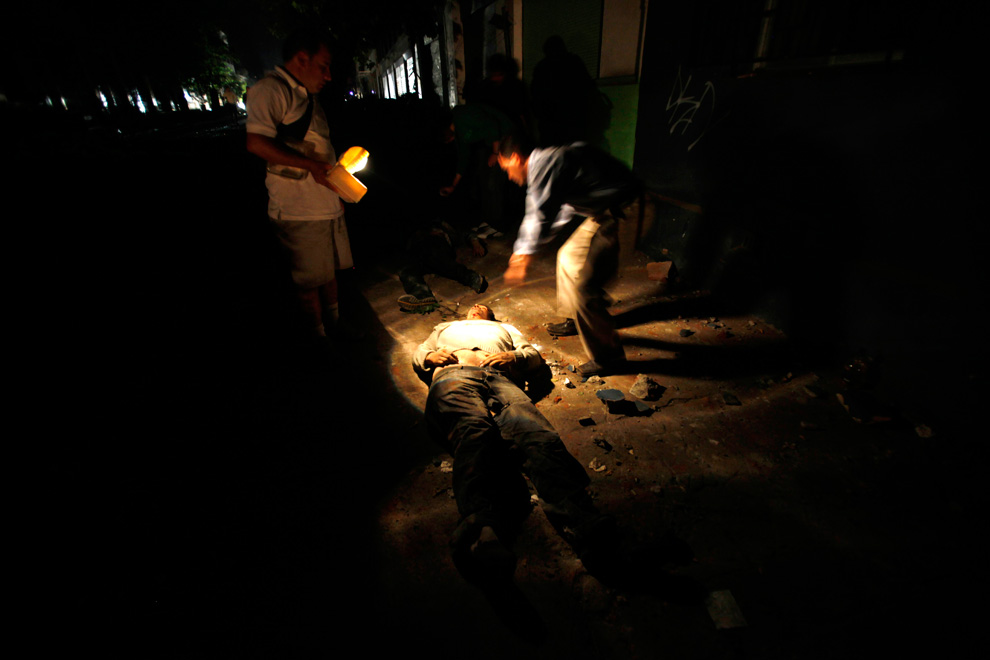
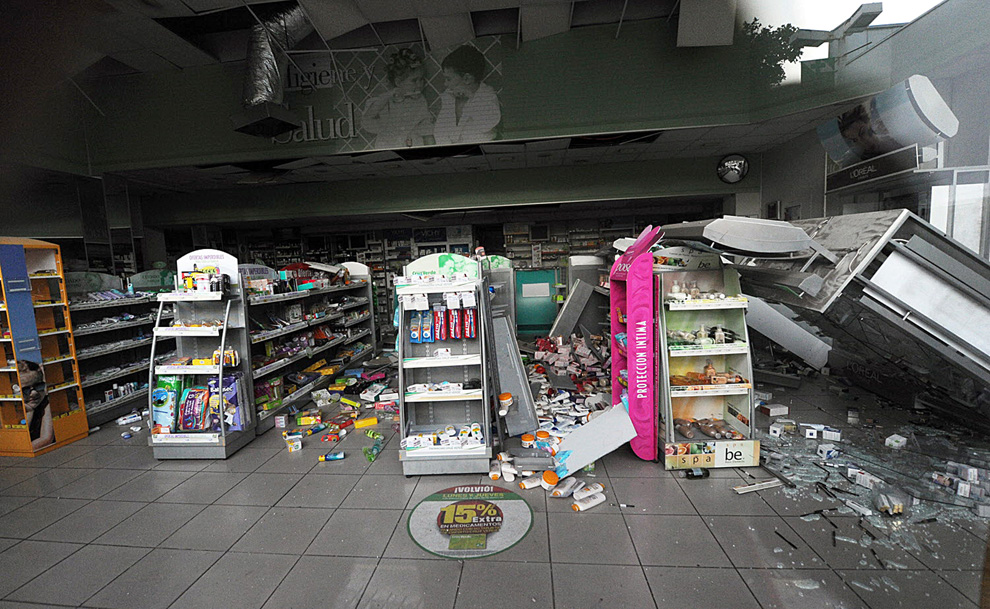 4.The walls and aisles of a pharmacy in Vina del Mar are seen destroyed after a huge 8.8-magnitude earthquake rocked Chile early on February 27, 2010. The massive quake plunged much of the Chilean capital, Santiago, into darkness as it snapped power lines and severed communications, and AFP journalists spoke of walls and masonry collapsing. People in pajamas fled onto the streets.
4.The walls and aisles of a pharmacy in Vina del Mar are seen destroyed after a huge 8.8-magnitude earthquake rocked Chile early on February 27, 2010. The massive quake plunged much of the Chilean capital, Santiago, into darkness as it snapped power lines and severed communications, and AFP journalists spoke of walls and masonry collapsing. People in pajamas fled onto the streets.  5.People walk along a highway with a collapsed bridge in the background in the outskirts of Santiago after a huge 8.8-magnitude earthquake rocked Chile early on February 27, 2010.
5.People walk along a highway with a collapsed bridge in the background in the outskirts of Santiago after a huge 8.8-magnitude earthquake rocked Chile early on February 27, 2010.  6.A police officer controls the traffic aside of an elevated highway that collapsed in Santiago following a powerful earthquake in central Chile, Saturday, Feb. 27, 2010.
6.A police officer controls the traffic aside of an elevated highway that collapsed in Santiago following a powerful earthquake in central Chile, Saturday, Feb. 27, 2010. 
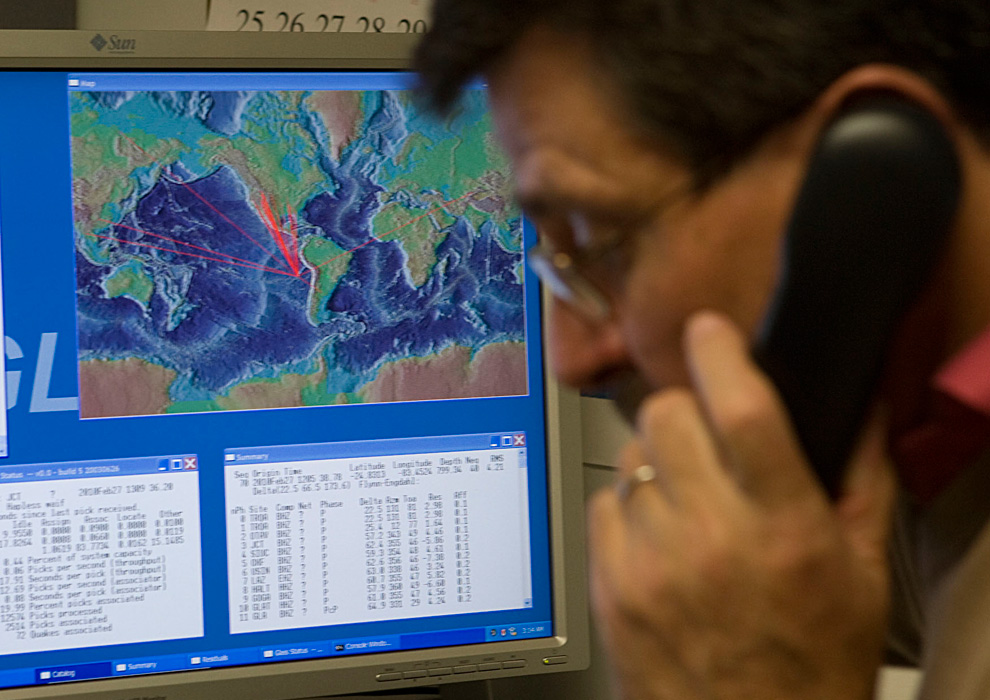
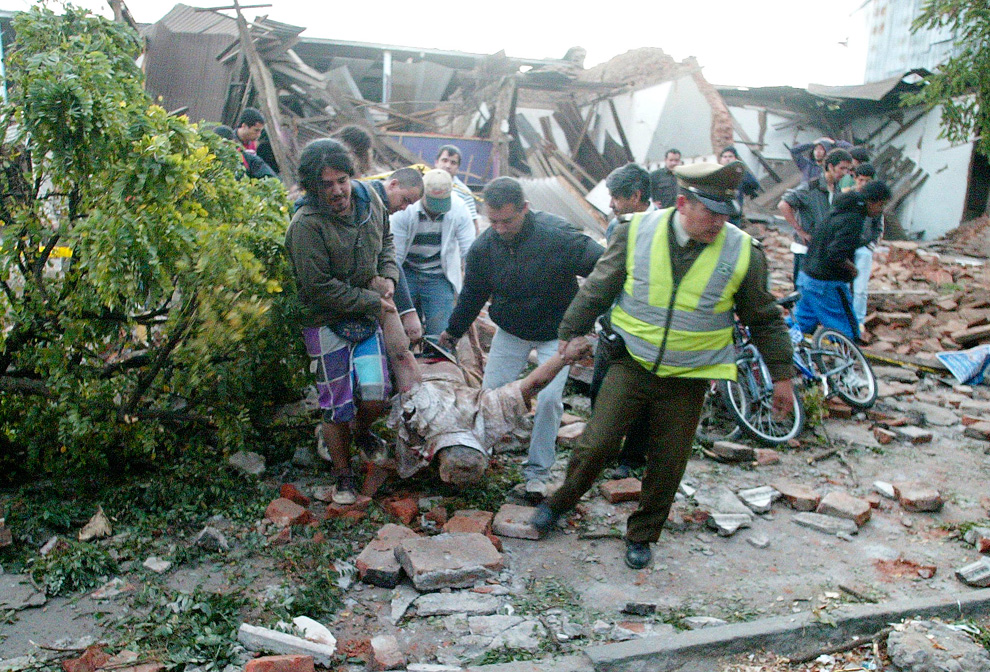
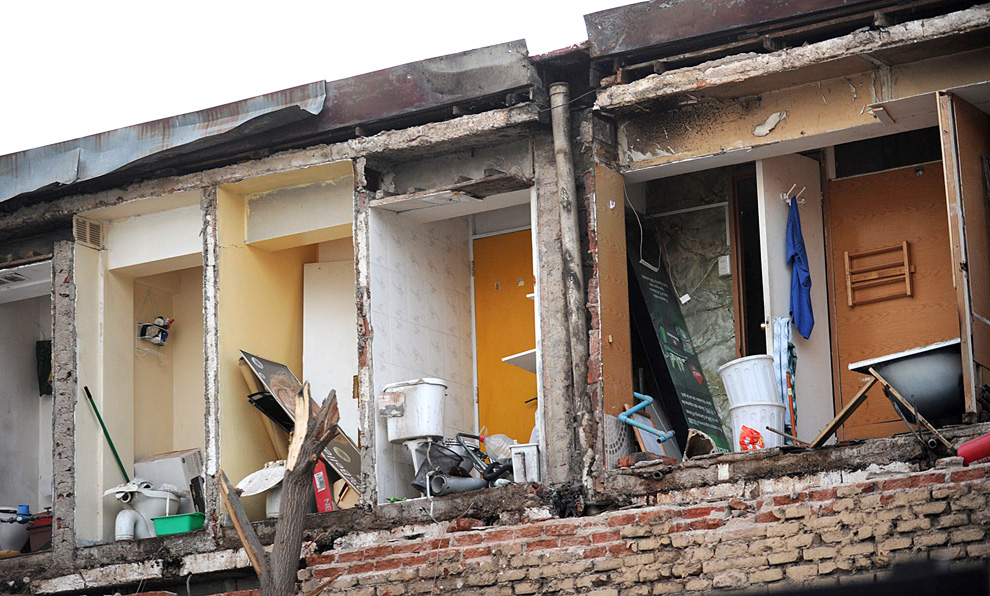
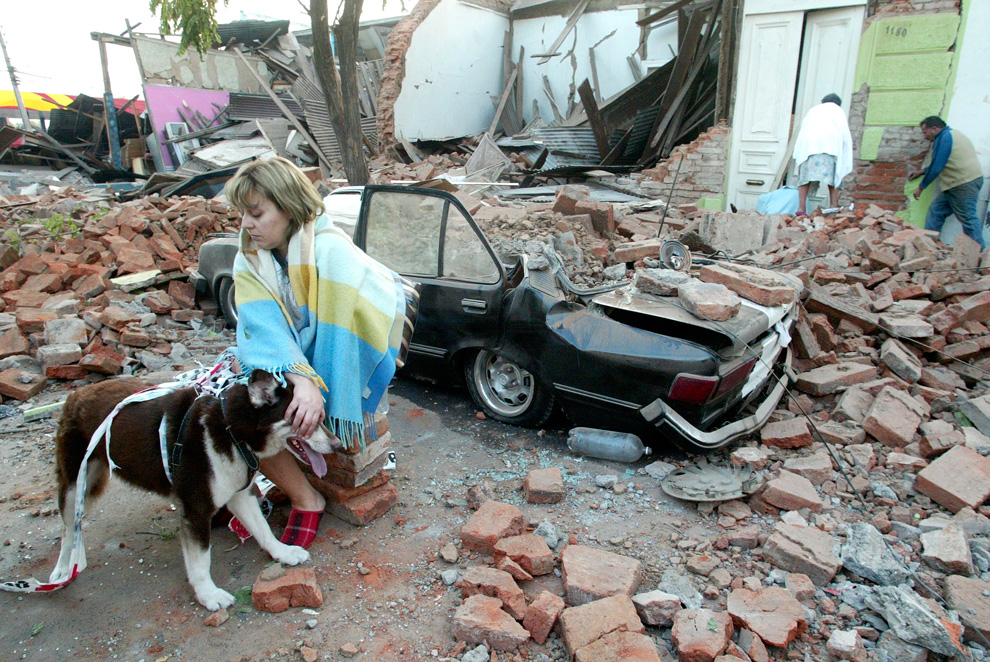
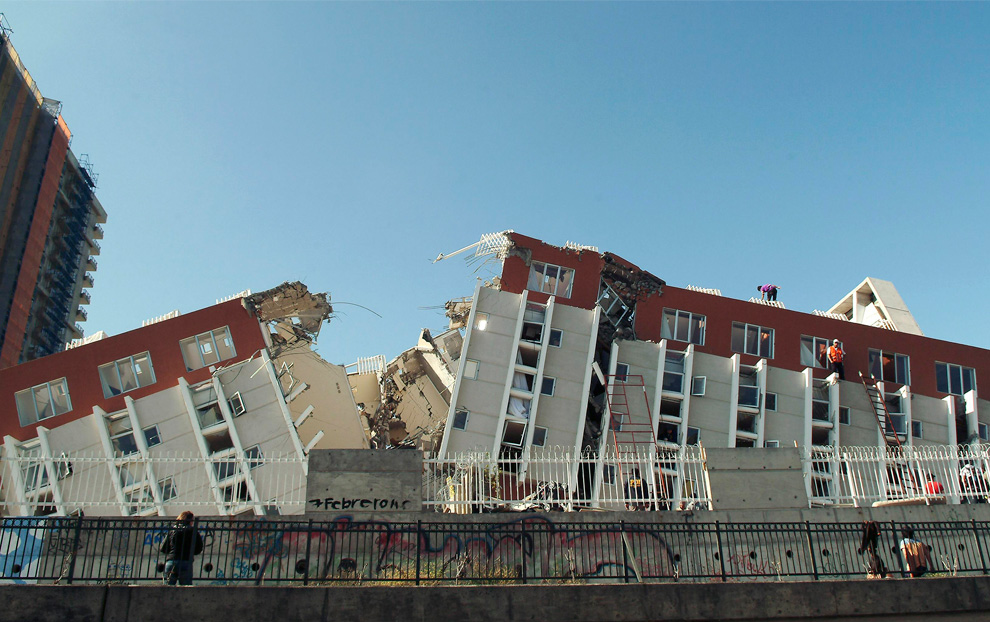
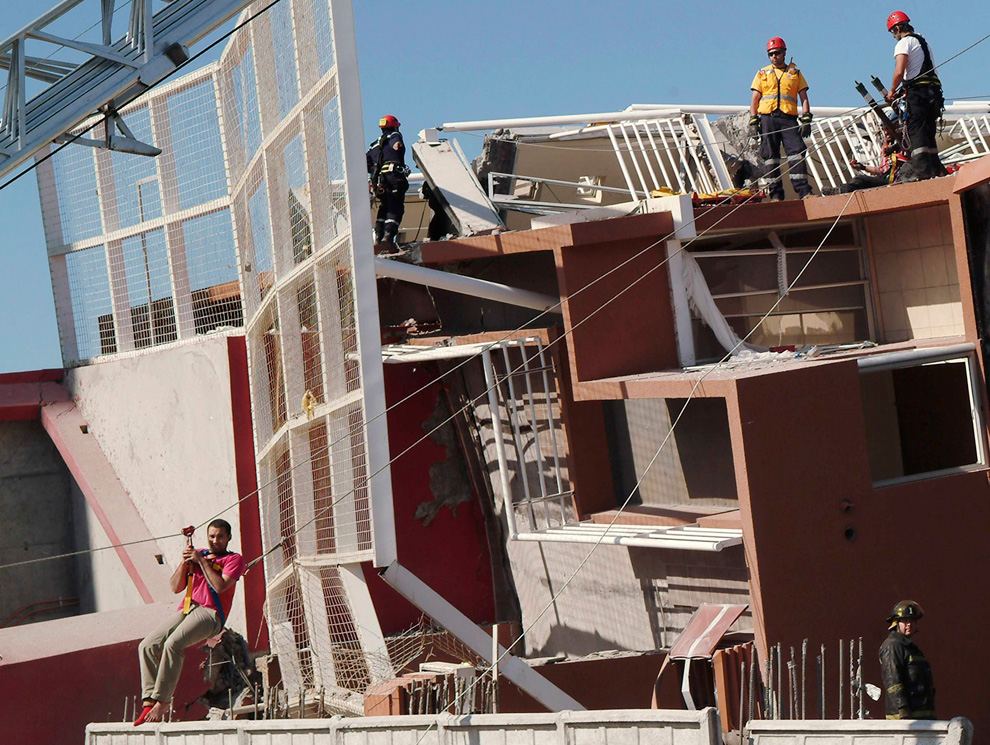
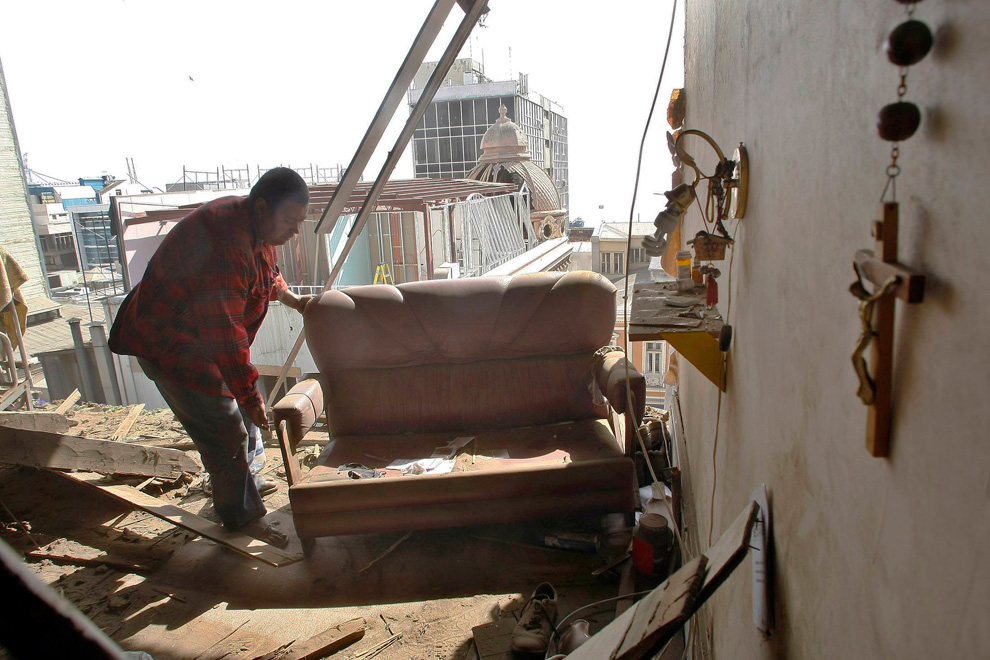
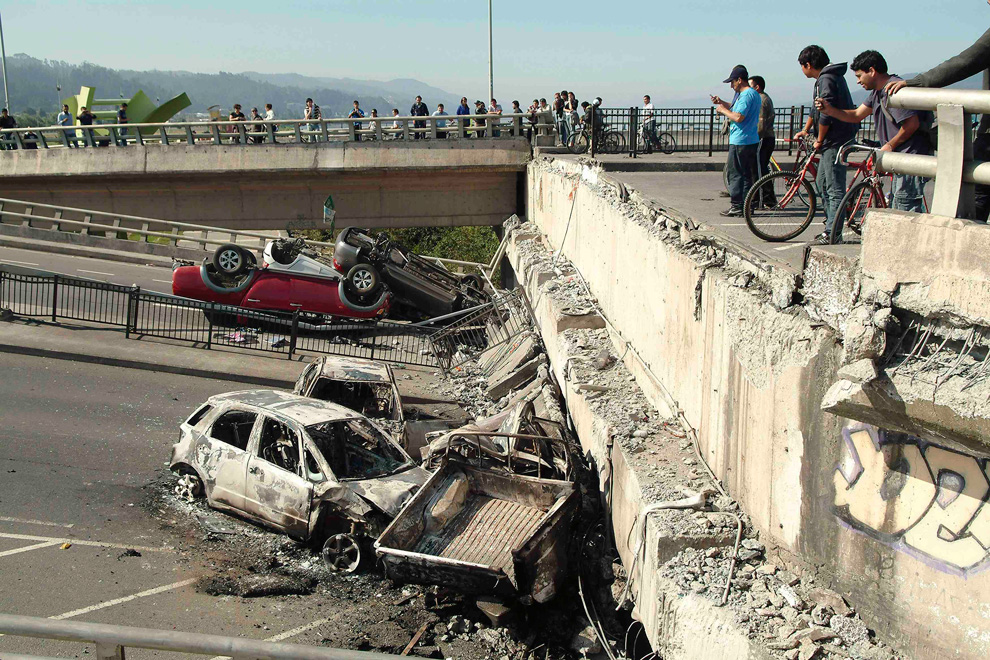
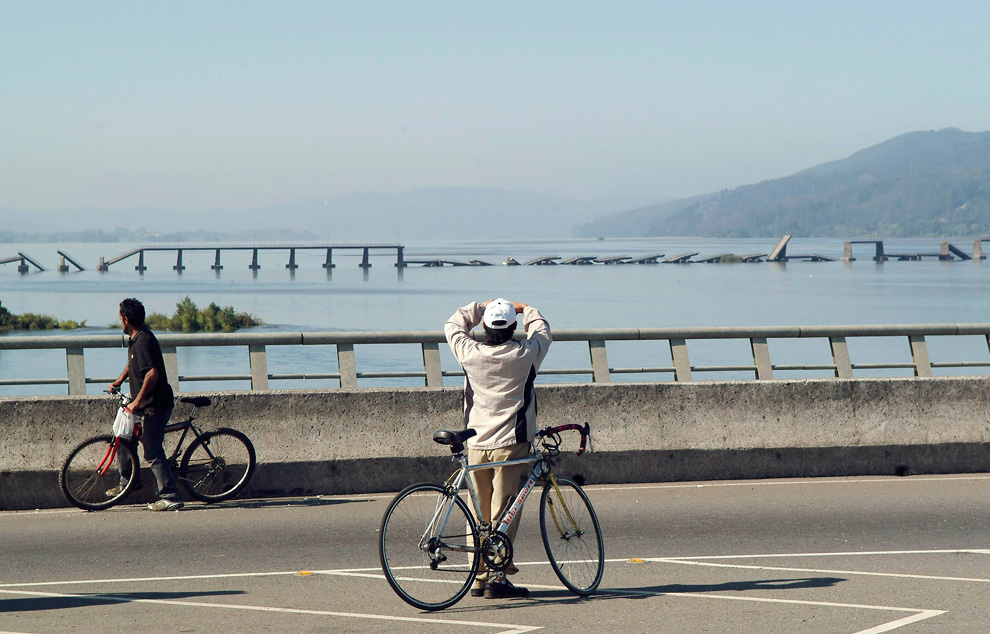
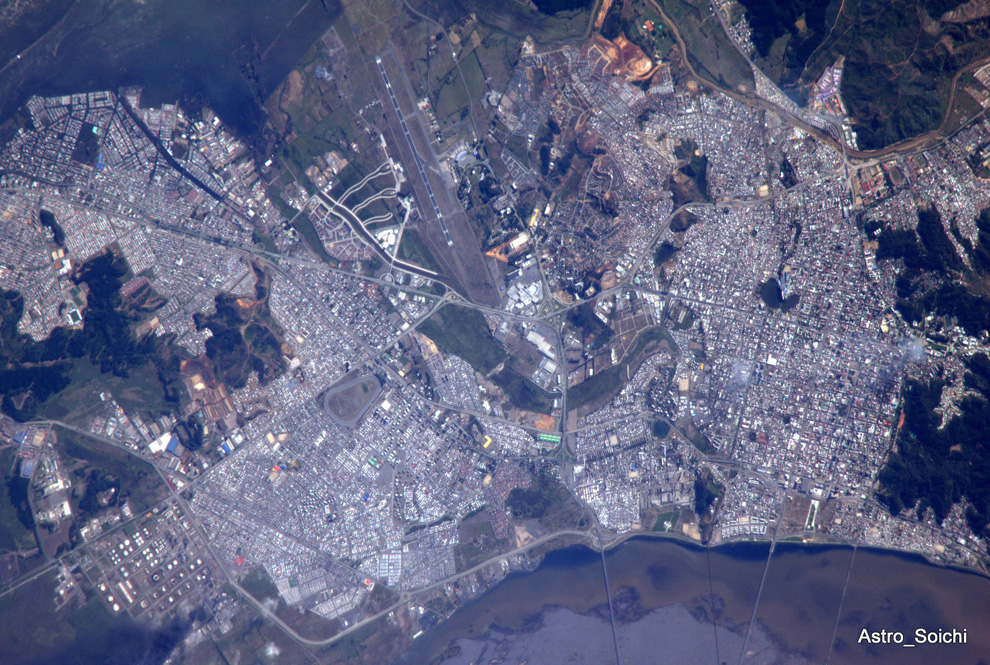
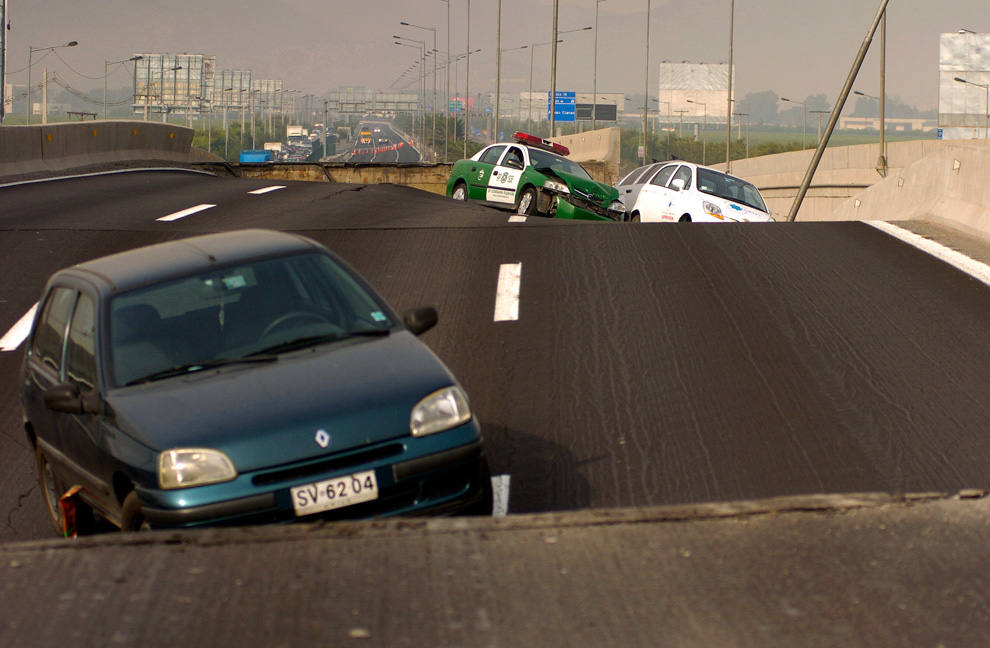
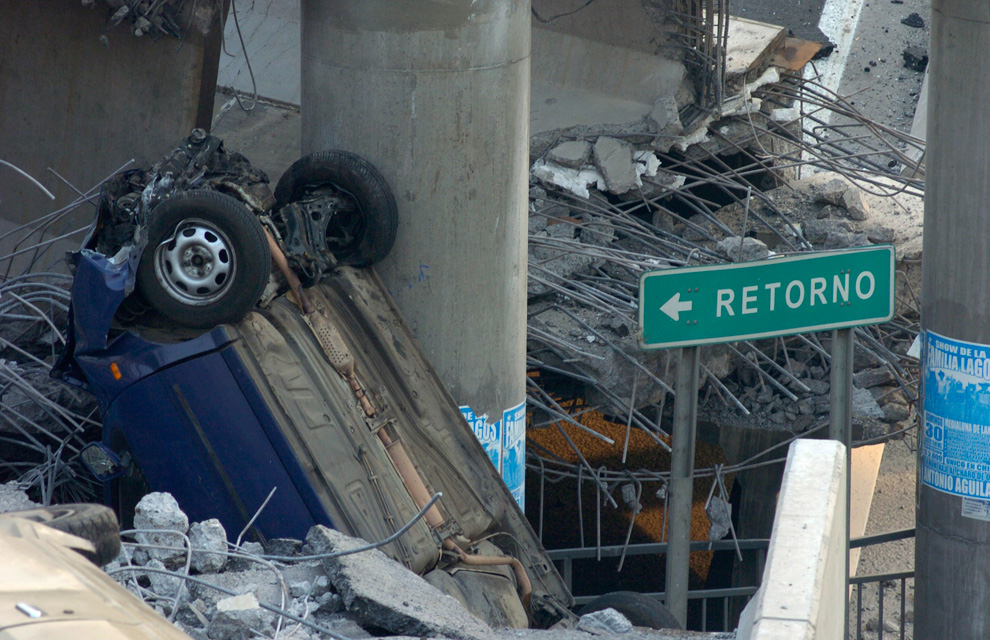
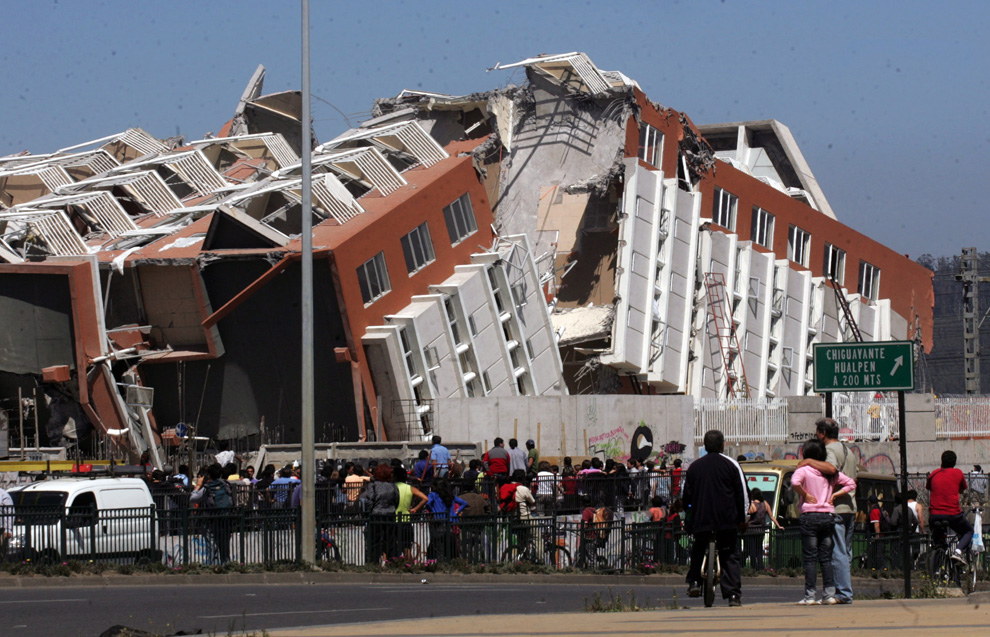 22.Residents look at a collapsed building in Concepcion, Chile, Saturday Feb. 27, 2010 after an 8.8-magnitude struck central Chile. The epicenter was 70 miles (115 kilometers) from Concepcion, Chile's second-largest city.
22.Residents look at a collapsed building in Concepcion, Chile, Saturday Feb. 27, 2010 after an 8.8-magnitude struck central Chile. The epicenter was 70 miles (115 kilometers) from Concepcion, Chile's second-largest city.
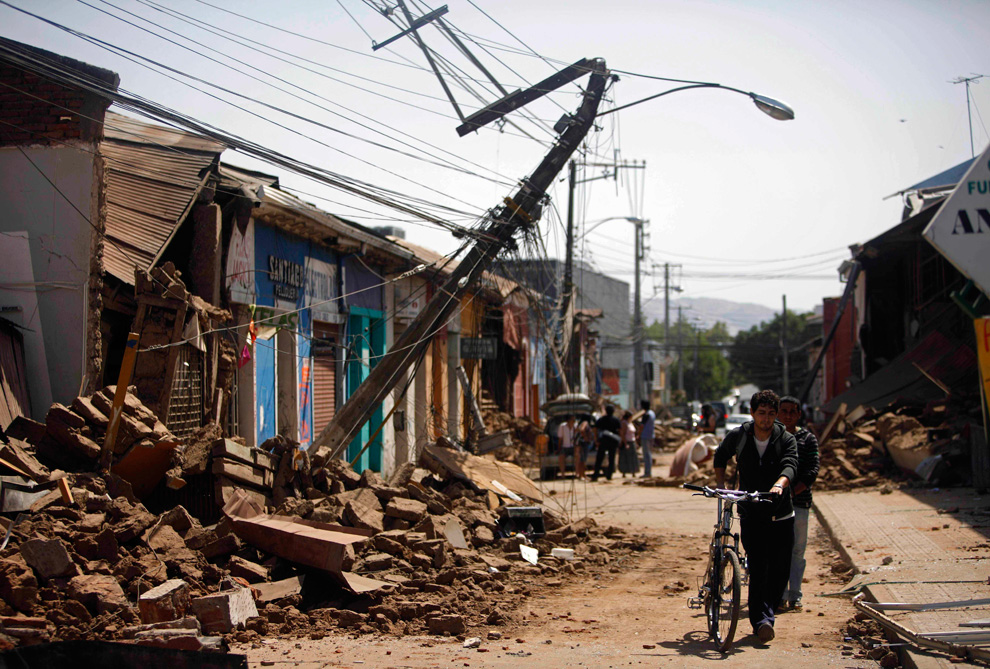
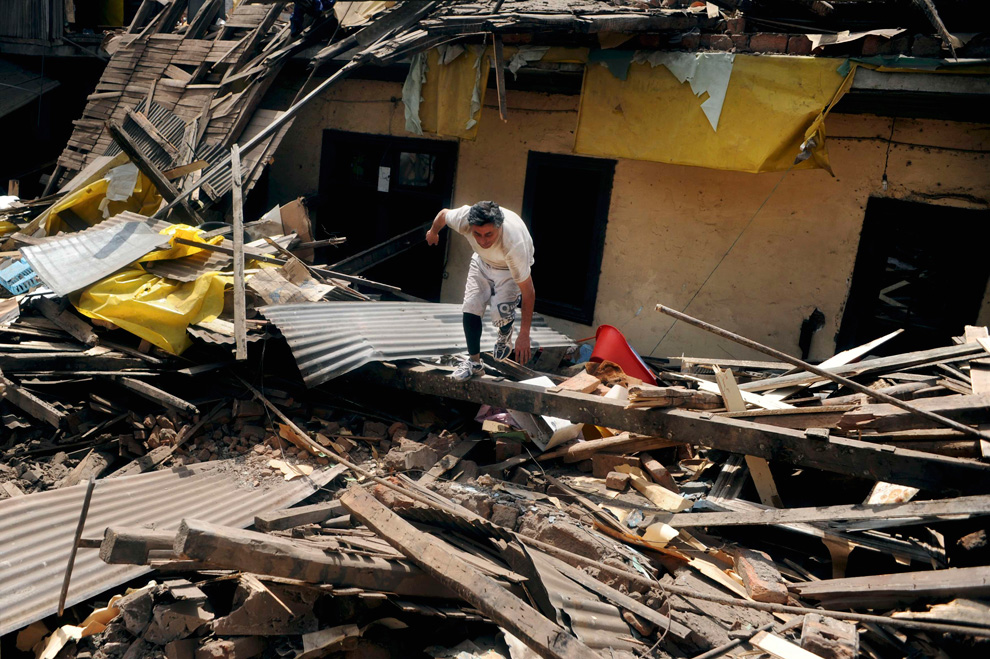
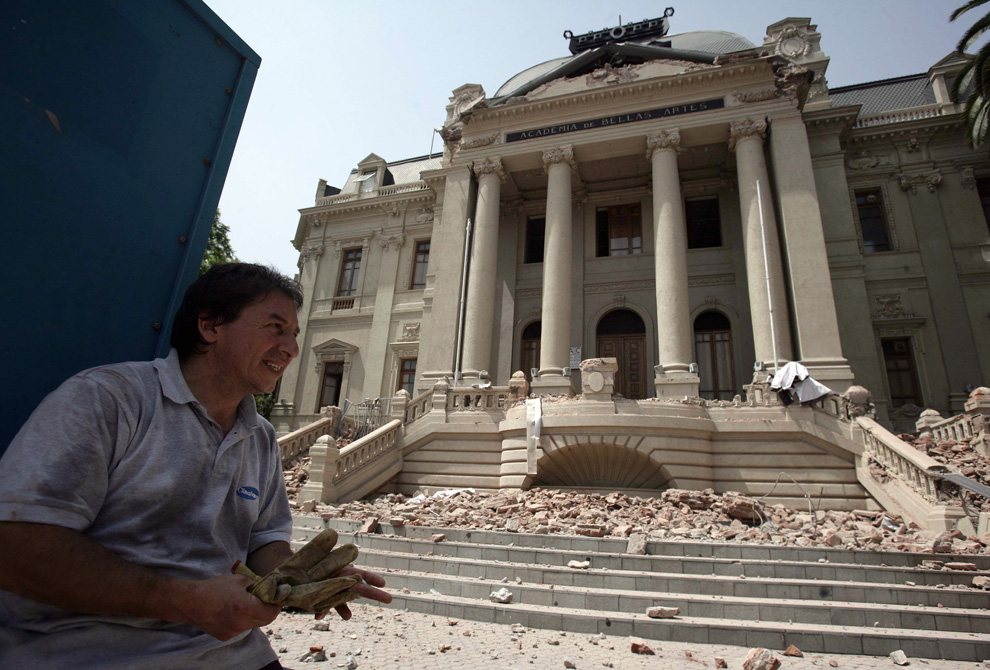
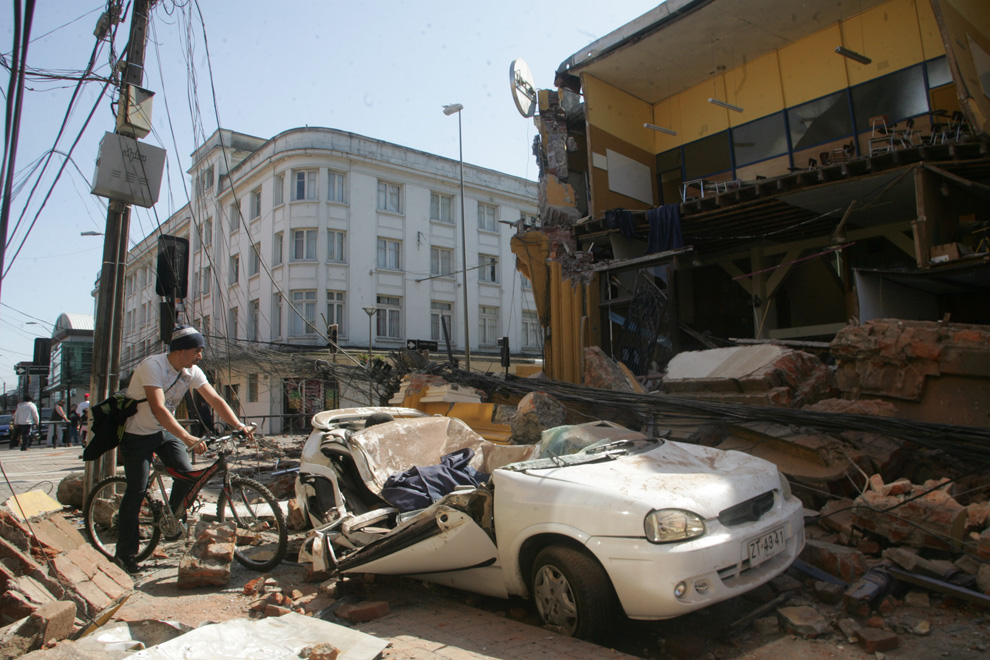
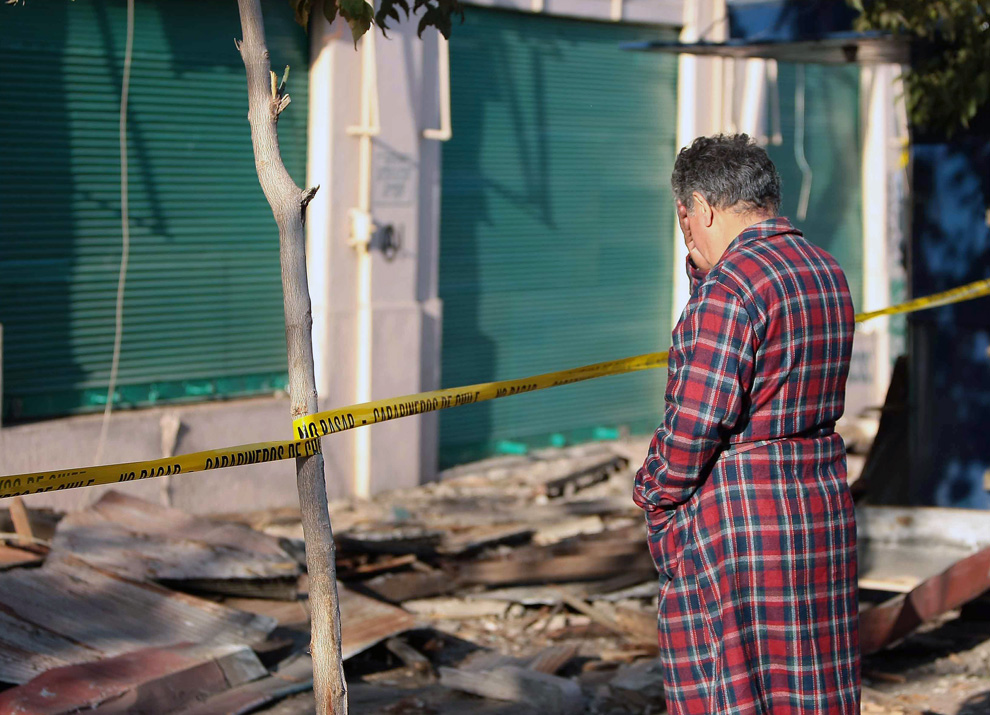


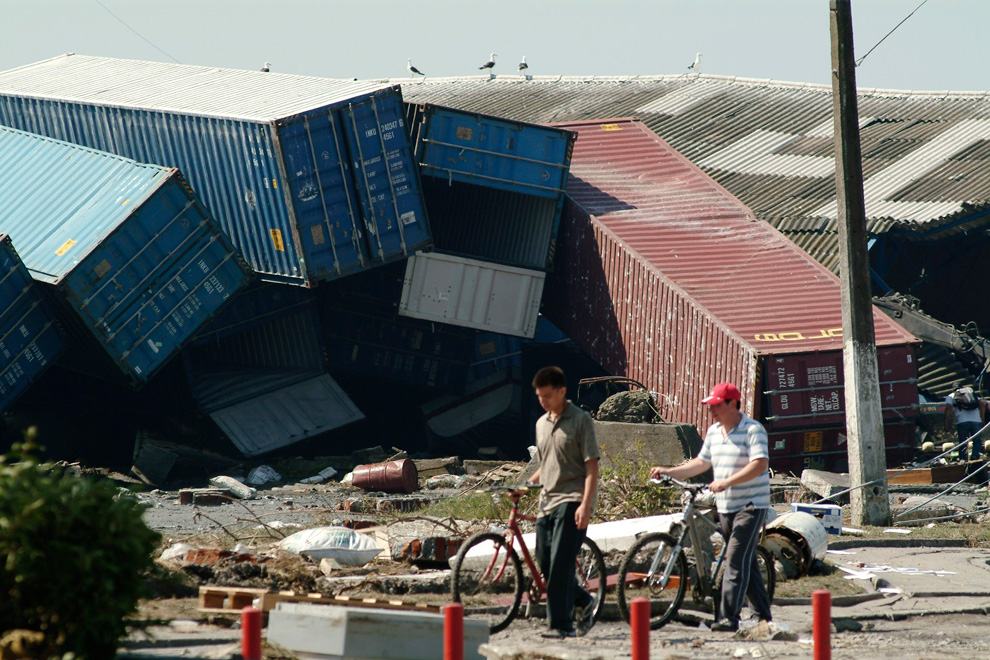
 35.A policeman looks at cars washed against an apartment building by a wave generated by an earthquake in Talcahuano Port, near Concepcion, Chile on February 27, 2010.
35.A policeman looks at cars washed against an apartment building by a wave generated by an earthquake in Talcahuano Port, near Concepcion, Chile on February 27, 2010.
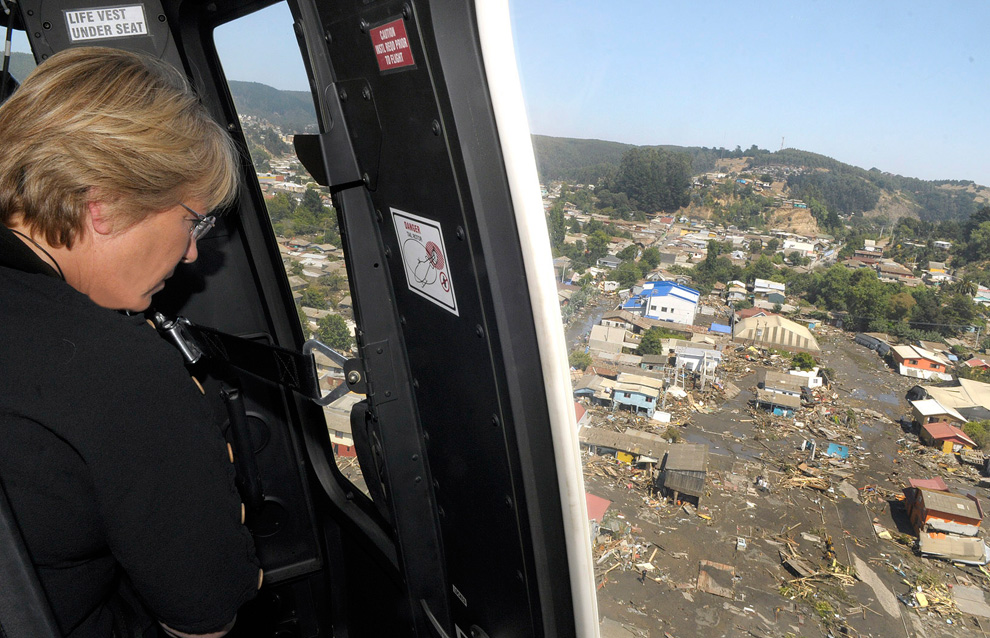
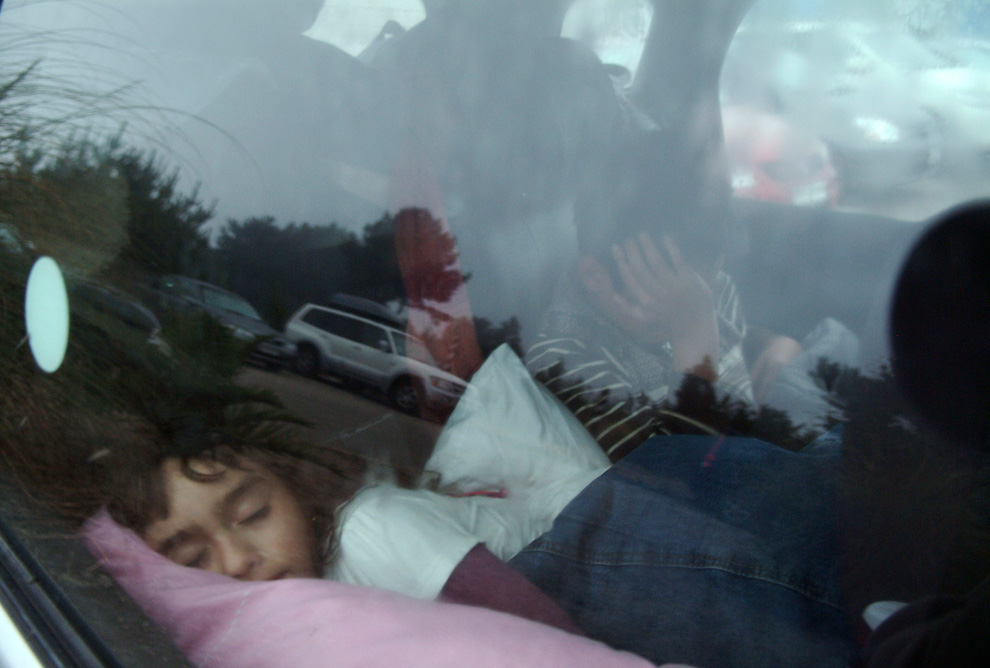


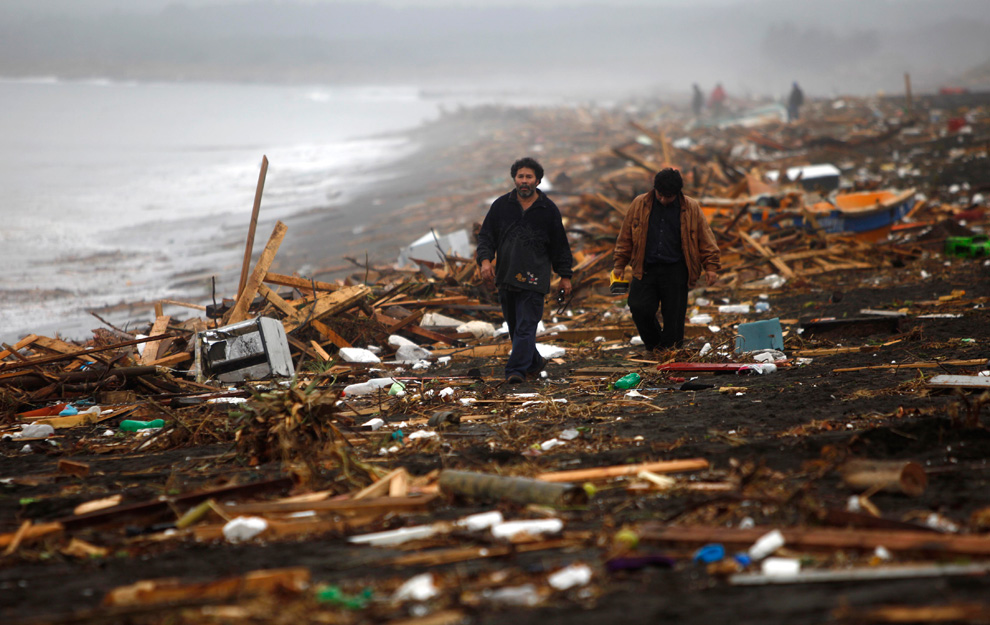
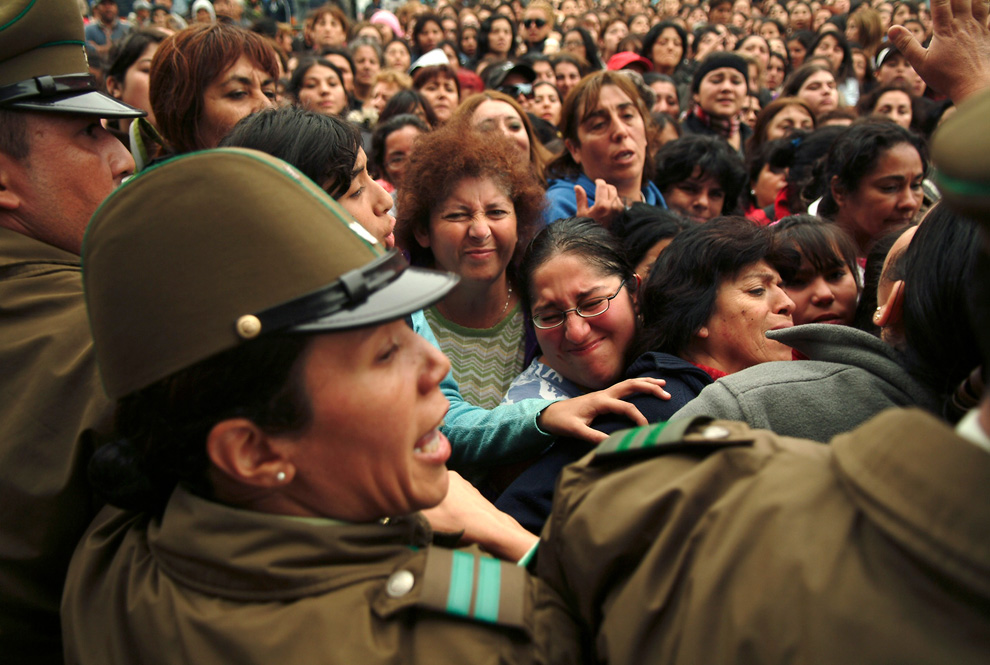

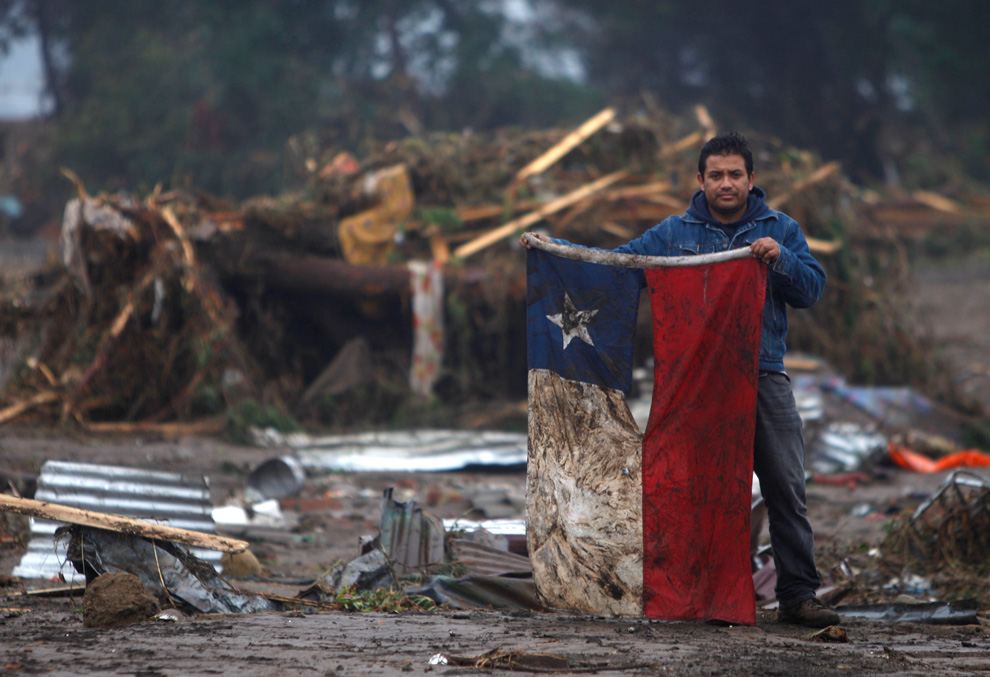
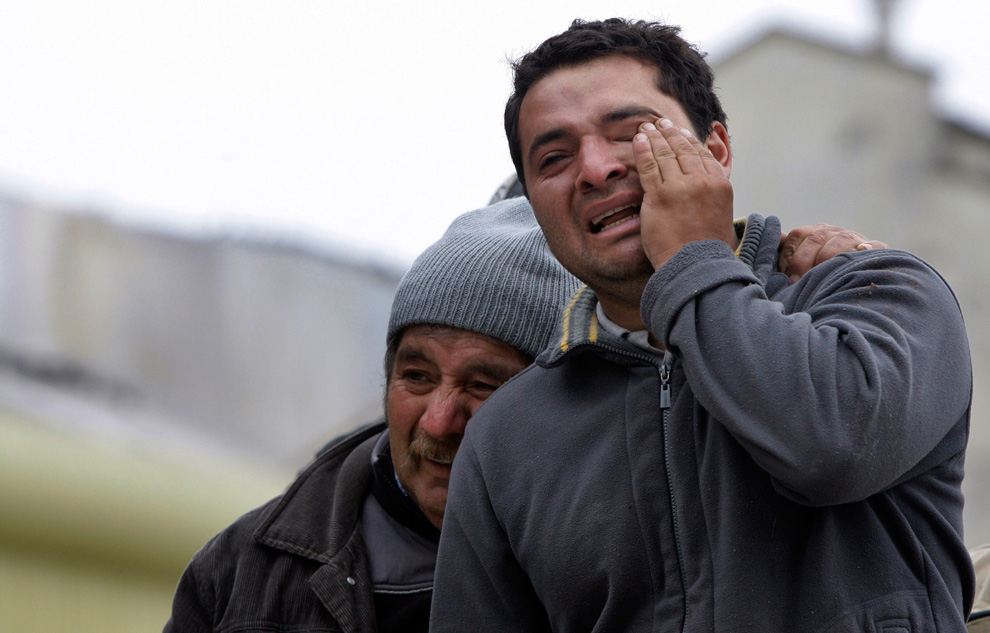

2.A resident of Talca, Chile, walks amid debris of a destroyed house after a powerful earthquake struck the country early Saturday, Feb. 27, 2010.

3.Residents look at the body of a dead man lying in a street of Talca, some 275 kilometers south of Santiago, Saturday, Feb. 27, 2010, after an 8.8-magnitude struck central Chile. The quake hit 200 miles (325 kilometers) southwest of the capital and the epicenter was just 70 miles (115 kilometers) from Concepcion, Chile's second-largest city.
 4.The walls and aisles of a pharmacy in Vina del Mar are seen destroyed after a huge 8.8-magnitude earthquake rocked Chile early on February 27, 2010. The massive quake plunged much of the Chilean capital, Santiago, into darkness as it snapped power lines and severed communications, and AFP journalists spoke of walls and masonry collapsing. People in pajamas fled onto the streets.
4.The walls and aisles of a pharmacy in Vina del Mar are seen destroyed after a huge 8.8-magnitude earthquake rocked Chile early on February 27, 2010. The massive quake plunged much of the Chilean capital, Santiago, into darkness as it snapped power lines and severed communications, and AFP journalists spoke of walls and masonry collapsing. People in pajamas fled onto the streets.  5.People walk along a highway with a collapsed bridge in the background in the outskirts of Santiago after a huge 8.8-magnitude earthquake rocked Chile early on February 27, 2010.
5.People walk along a highway with a collapsed bridge in the background in the outskirts of Santiago after a huge 8.8-magnitude earthquake rocked Chile early on February 27, 2010.  6.A police officer controls the traffic aside of an elevated highway that collapsed in Santiago following a powerful earthquake in central Chile, Saturday, Feb. 27, 2010.
6.A police officer controls the traffic aside of an elevated highway that collapsed in Santiago following a powerful earthquake in central Chile, Saturday, Feb. 27, 2010. 
7.Smoke from a burning building fills the sky in the outskirts of Santiago after a huge 8.8-magnitude earthquake rocked Chile on February 27, 2010.

9.With a computer graphic showing the possible path of tsunami waves from an earthquake in Chile, Dr. Charles McCreery speaks on the phone at the Pacific Tsunami Warning Center, Saturday, Feb. 27, 2010 in Ewa Beach, Hawaii. The State of Hawaii is under a tsunami warning after an 8.8 magnitude earthquake rattled Chile today.

10.A police officer and residents carry a body from a destroyed house in Talca, Chile, some 275 kilometers south of Santiago, Saturday, Feb. 27, 2010 after an 8.8-magnitude struck central Chile.

11.The walls of a hotel in Vina del Mar are seen destroyed after a huge 8.8-magnitude earthquake rocked Chile on February 27, 2010.

12.A woman sits in front a quake-damaged house in Talca, Chile, after a 8.8-magnitude earthquake struck the country early Saturday, Feb. 27, 2010.

13.Rescue workers search for victims and survivors after an apartment complex collapsed during an earthquake in Concepcion some 100 km (62 miles) south of the epicenter, February 27, 2010.

14.A survivor is lowered by a cable as rescue workers search for victims after an apartment complex collapsed during an earthquake in Concepcion, Chile on February 27, 2010.

15.A man moves his belongings inside his home destroyed in an earthquake in Valparaiso February 27, 2010.

17.People observe a highway and cars destroyed by an earthquake in Concepcion, Chile on February 27, 2010.

18.Cyclists observe a bridge that collapsed in an earthquake in Concepcion, Chileon February 27, 2010.
1st Update, 1:35 pm Eastern Time

19.Photograph taken this morning of Concepcion, Chile by astronaut Soichi Noguchi, aboard the International Space Station: "Concepcion, Chile. Mega earthquake (M8.3) hit this city this morning. Photo taken a few hours ago. We pray for you." On TwitPic

20.Vehicles sit on a destroyed motorway in Santiago following a powerful earthquake in southern Chile, Saturday, Feb. 27, 2010.

21.An overturned vehicle sits amidst rubble of a collapsed elevated highway in Santiago, Saturday, Feb. 27, 2010. A powerful earthquake struck central Chile early Saturday.
 22.Residents look at a collapsed building in Concepcion, Chile, Saturday Feb. 27, 2010 after an 8.8-magnitude struck central Chile. The epicenter was 70 miles (115 kilometers) from Concepcion, Chile's second-largest city.
22.Residents look at a collapsed building in Concepcion, Chile, Saturday Feb. 27, 2010 after an 8.8-magnitude struck central Chile. The epicenter was 70 miles (115 kilometers) from Concepcion, Chile's second-largest city.
23.A man carries a child next to a damaged building in Concepcion, Chile, Saturday Feb. 27, 2010 after an 8.8-magnitude struck central Chile.

24.A resident walks along a damaged street in Talca, Chile, Saturday, Feb. 27, 2010, after a powerful earthquake struck central Chile.
2nd Update, 4:30 pm Eastern Time

26.An immigrant from Peru steps over debris after a major earthquake destroyed homes along Santo Domingo Street in Santiago February 27, 2010.

27.A man looks at the damage to the Accademy of Fine Arts building in Santiago after a huge 8.8-magnitude earthquake rocked Chile early morning killing at least 147 people, on February 27, 2010.

28.A man rides his bicycle past a destroyed building in Concepcion, Chile, Saturday Feb. 27, 2010 after an 8.8-magnitude struck central Chile. The epicenter was 70 miles (115 kilometers) from Concepcion, Chile's second-largest city.

29.A man looks at rubble in Valparaiso, Chile, after a huge 8.8-magnitude earthquake rocked the country early morning killing at least 147 people, on February 27, 2010.
3rd Update, 6:15 pm Eastern Time

30.A destroyed bridge is seen next to Talca some 300 km (186 miles) south of Santiago February 27, 2010.

33.Fishing boats washed up by a wave generated by an earthquake are seen in Talcahuano Port, a city just outside Concepcion, Chile on February 27, 2010.

34.Children walk past shipping containers washed up by a wave caused by an earthquake in Talcahuano Port, a city just outside Concepcion, Chile on February 27, 2010.
 35.A policeman looks at cars washed against an apartment building by a wave generated by an earthquake in Talcahuano Port, near Concepcion, Chile on February 27, 2010.
35.A policeman looks at cars washed against an apartment building by a wave generated by an earthquake in Talcahuano Port, near Concepcion, Chile on February 27, 2010. 4th (and final) Update, 12:15 pm Eastern Time, 2/28

36.Chile's President Michelle Bachelet looks at collapsed houses after an earthquake in Concepcion, Chile, Saturday, Feb. 27, 2010.

38.Residents sleep in their cars, some because their homes are damaged and others for fear of aftershocks, after an earthquake in Concepcion February 28, 2010.

39.A car is seen submerged in a flooded area due to a tsunami in Talcahuano the day after a huge 8.8-magnitude earthquake rocked Chile early morning killing at least 300 people, on February 28, 2010. The South American nation has been hit by numerous aftershocks, some reaching over 6 points on the Richter scale, as well as heavy damages in coastal towns resulting from subsequent tsunamis.

40.A flooded area is seen after an earthquake in Pelluhue, some 322 kms, about 200 miles, southwest of Santiago, Sunday, Feb. 28, 2010.

41.People walk along the shore after an earthquake in Pelluhue, some 322 kms, about 200 miles, southwest of Santiago, Sunday, Feb. 28, 2010.

42.Residents try to force their way into a supermarket to buy food and essentials as police try to keep order after an earthquake in Concepcion February 28, 2010.

43.Residents loot a supermarket after an earthquake in Concepcion February 28, 2010. Chilean rescuers used shovels and sledgehammers on Sunday to find survivors of a huge earthquake in Chile that unleashed a Pacific tsunami and triggered looting by desperate and hungry residents.

44.A man holds up a Chilean flag in a flooded area after an earthquake in Pelluhue, some 322 kms, about 200 miles, southwest of Santiago, Sunday, Feb. 28, 2010.

45.Relatives of victims of an earthquake cry outside a destroyed building in Concepcion, Sunday, Feb. 28, 2010.
Subscribe to:
Posts (Atom)














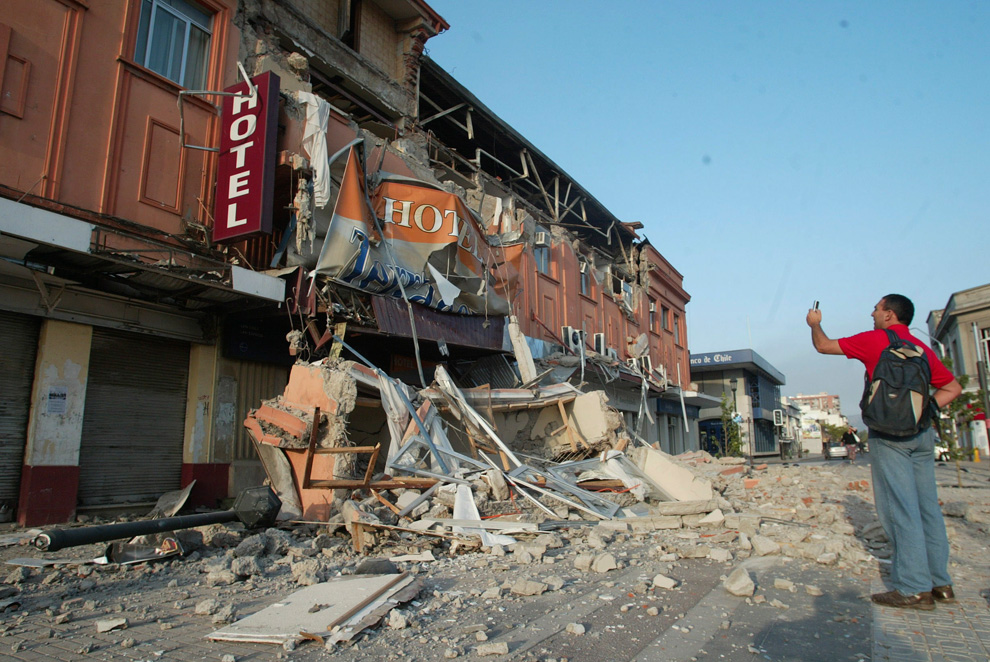
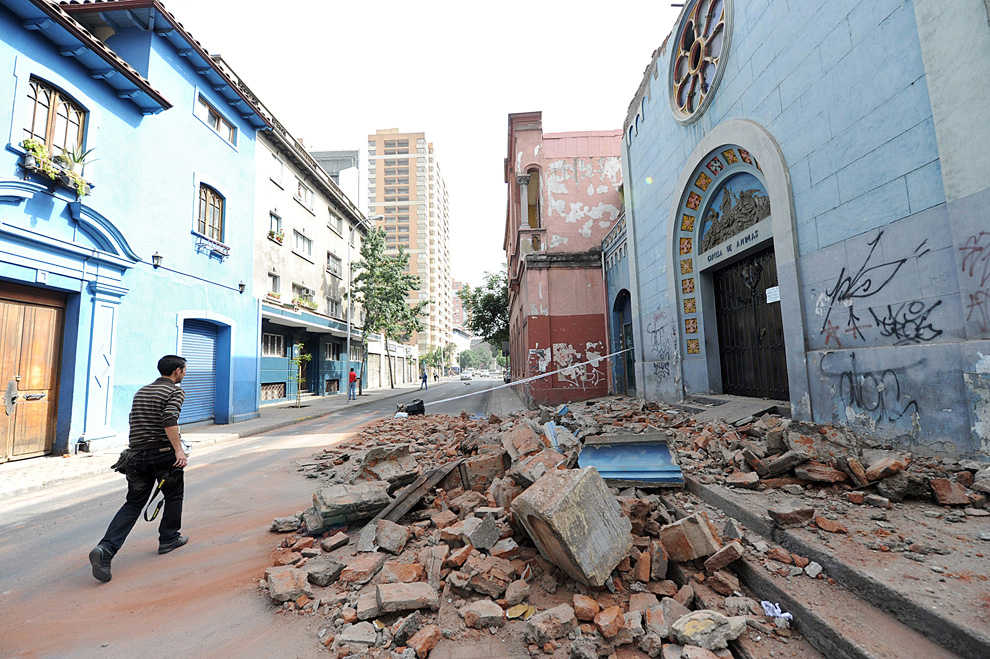 16.A man walks past a wrecked church in Santiago, Chile on February 27, 2010.
16.A man walks past a wrecked church in Santiago, Chile on February 27, 2010. 